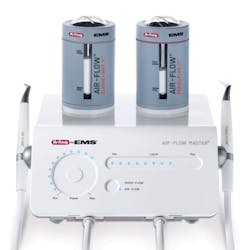5 reasons to adopt air polishing using AIRFLOW Therapy
Sponsored article
Dentists are always looking for ways to offer superior patient care while also improving practice efficiencies and profits. The goal is to “work smarter, not harder,” and the AIRFLOW® Therapy advanced biofilm management system certainly makes that possible.
How? This system isn’t like the air polishers that dental professionals have tried in the past. Designed to be used with low-abrasive powders, AIRFLOW can be used on every patient during hygiene appointments to remove biofilm throughout the mouth. It is safe to use on restorations, implants, orthodontics, and root surfaces. The versatile and comfortable hand pieces can remove biofilm on difficult-to-reach and delicate surfaces where rubber cups have limited access or hand and power scaling take longer. This innovative product is changing the way dental professionals view air polishing systems, bringing numerous benefits to practices.
There are a variety of ways incorporating this system can have an immediate, positive impact on dental practices—making it a must-have in any office. Here are five of the top ways AIRFLOW Therapy can help a practice:
1. It provides better biofilm management. Biofilm, the main cause of periodontal inflammation and dental caries, must be mechanically removed, and thorough removal can be difficult with traditional methods of instrumentation and rubber cup polishing.
With AIRFLOW Therapy, hygienists can completely and efficiently remove biofilm subgingivally, around restorations, on root surfaces and implants, and in periodontal pockets. Other air polishing systems are focused on supragingival procedures and stain removal, because high abrasive powders are limited to enamel-only use. When hygienists are able to comprehensively and efficiently remove biofilm during appointments, they can spend more time on other procedures.
Compared to instrumentation, AIRFLOW Therapy is more efficient and effective for biofilm removal. With this system, AIRFLOW can replace the labor intensive “stroke by stroke” technique hygienists typically use. Instead, hand and ultrasonic scaler are only used for hard deposit removal, also made easier with the biofilm removed in advance.
Incorporating AIRFLOW Therapy will improve how hygienists handle biofilm management, saving time and leading to healthier, happier patients.
3. It makes treatment more comfortable. When dental professionals think of air polishing systems, they often think of the messy, gritty, powders of the past—the type of powders that patients associate with negative experiences. That’s not a worry with AIRFLOW. This system is built for comfort, and uses low-abrasive powders that feel just like water. The “sting” patients have come to expect from abrasive powders is no longer an issue.
That’s because AIRFLOW's low abrasive powders are made with smaller particles. The PLUS Powder, for example, is made with erythritol, a sugar alcohol with a grain size of just 14 microns. The PERIO powder is made of glycine and has a particle size of 25 microns. The PLUS and PERIO AIRFLOW powders are ideal for supra and subgingival biofilm disruption and light to moderate stain removal and are safe on almost all surfaces.
AIRFLOW Classic features a smaller-particle sodium bicarbonate, with a grain size of 40 microns. This is a more comfortable option for patients with heavy staining when compared to larger-particle sodium bicarbonate powders in the market.
4. It’s safe for specialty care. AIRFLOW Therapy has been tested on various surfaces and materials to ensure it’s safe to use on delicate areas such as implants. Research shows that low abrasive air polishing is the most efficient and effective method for implant debridement. In addition, a specialized plastic nozzle can be used to reach around implant prosthetics and into periodontal pockets to effectively remove biofilm. AIRFLOW is versatile and expands what dental professionals can achieve chairside.
The “magical minutes” dentists get back can be used to boost practice production and revenue. The time can be spent talking with patients about additional services the practice offers, such as whitening and clear aligners, and educating them about the importance of going forward with treatment recommendations. These minutes also can go toward providing additional services and completing other important tasks, such as perio charting and critical screenings.
Finding ways to “work smarter, not harder” is vital to every practice’s success. Investing in products that achieve that goal saves time while also boosting patient retention numbers and leading to more referrals. AIRFLOW Therapy makes it possible to provide patients with optimal care, while also growing practice revenue. It’s a game changer that is transforming the way dental professionals manage biofilm.



